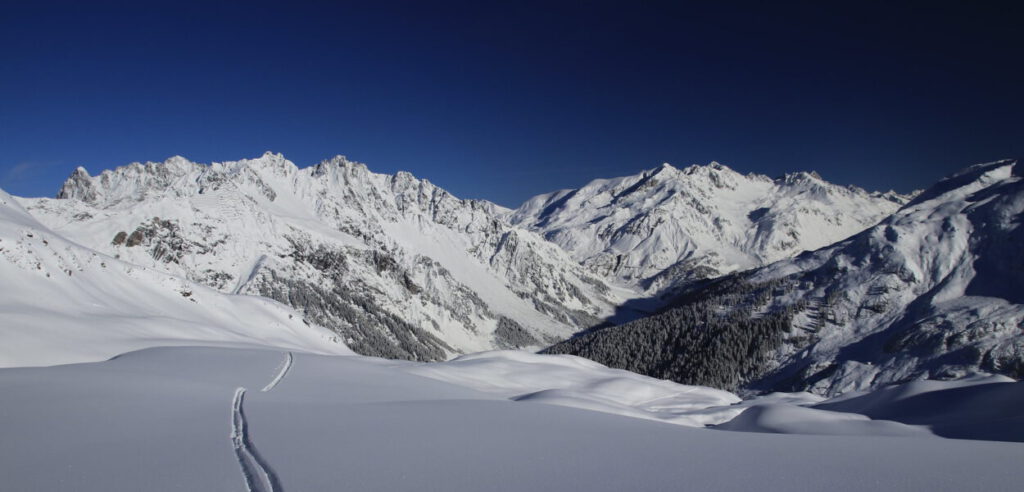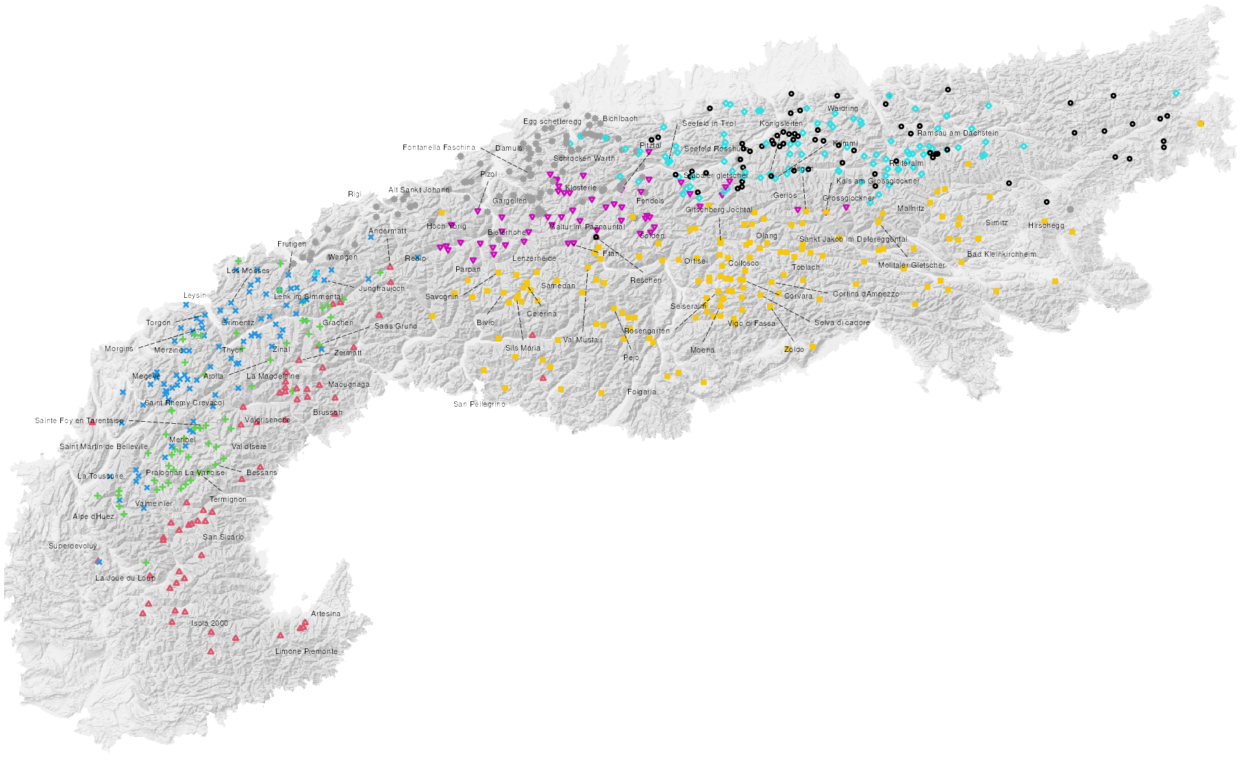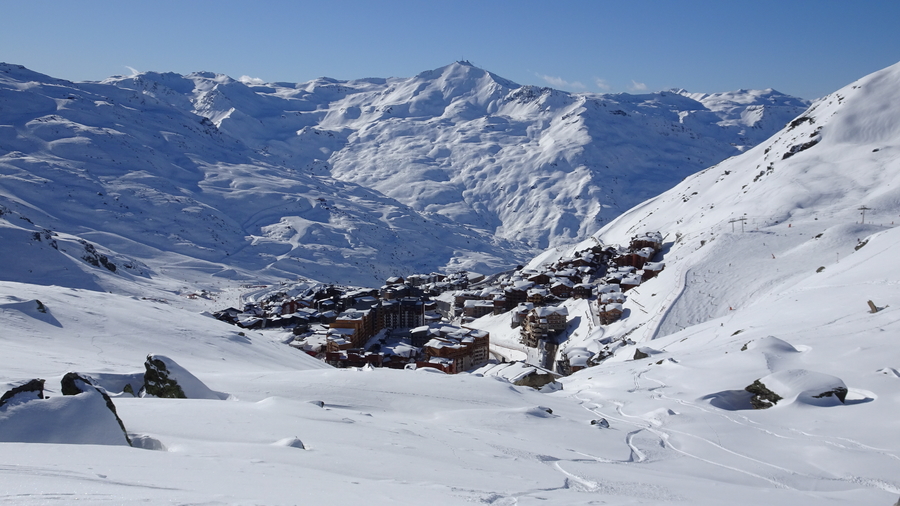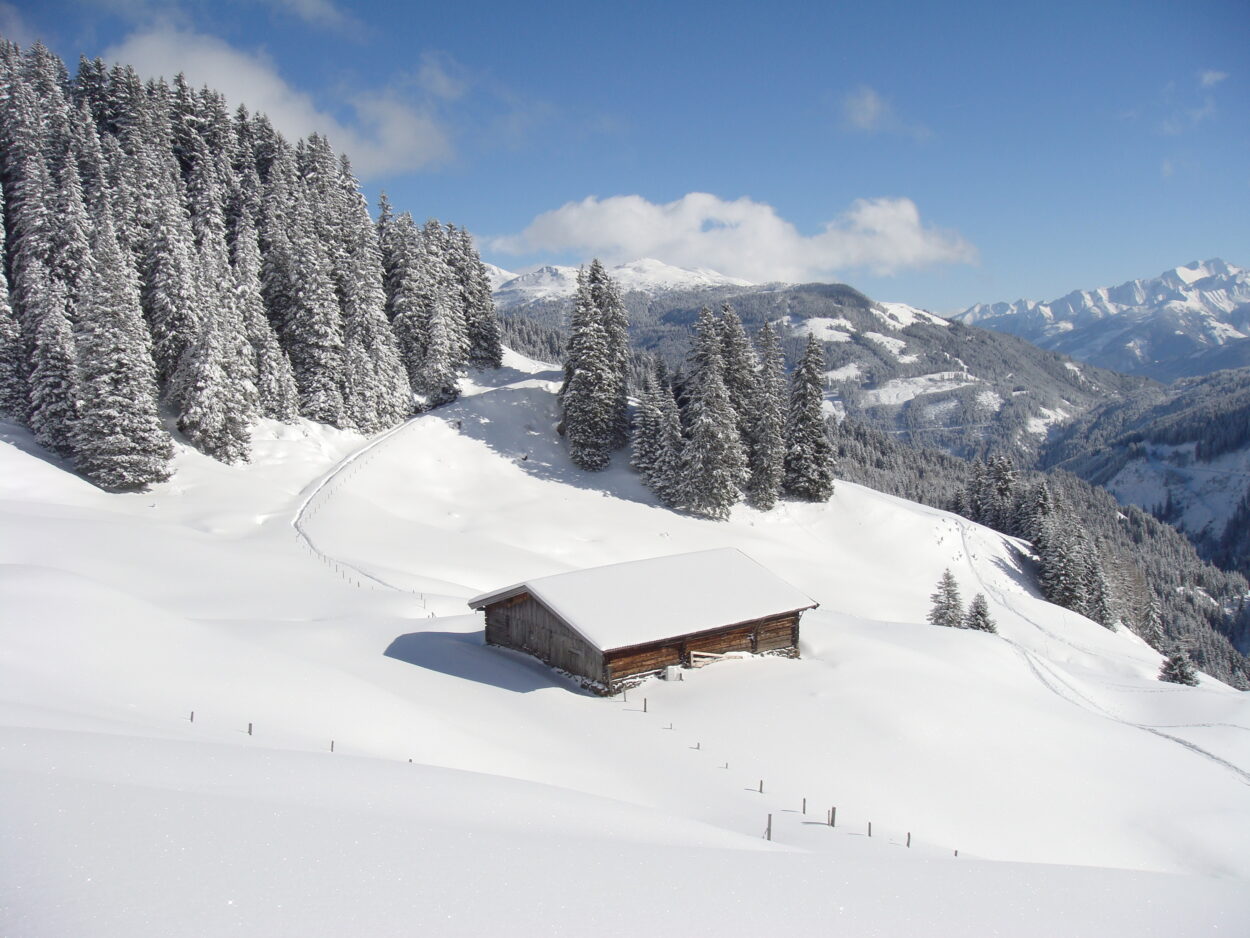As passionate winter sports enthusiasts, we’re constantly on the quest for the ultimate skiing or snowboarding experience. For us, it’s not just about carving turns down pristine slopes—it’s about immersing ourselves in the exhilarating embrace of snow-covered mountains. Yet, in a world where climate change is reshaping the very landscapes we love, our pursuit of the perfect powder day has become increasingly challenging.
Gone are the days when we could rely on traditional notions of snowfall patterns and seasonal consistency. Instead, we find ourselves grappling with the capricious whims of weather systems that seem to defy predictability. What was once a straightforward decision of which resort to visit has now become a complex calculus of climate data, snow forecasts, snow reports, and anecdotal accounts from fellow enthusiasts. It’s not just about where to find the deepest powder or the steepest terrain—it’s about finding ski resorts where snow conditions are reliably exceptional, week after week, season after season.
Erratic weather patterns and seasonal drift
The Alps are experiencing a warming trend that surpasses the global average, posing a complex puzzle for researchers to decipher. Beyond rising temperatures, concerns arise from unpredictable weather patterns, the looming threat of extreme weather events, and the unsettling phenomenon of stalled weather systems. Traditional seasonal norms are being disrupted, with winter’s coldest periods shifting from December to earlier months, and spring snowmelt accelerating, significantly shortening the ski season. Particularly in the Southern Alps, where snow depths typically trail behind those in the north, the decrease in snow depth below 1500 meters stands out as a stark reminder of the region’s vulnerability to climate change.
Beyond the hype
Amidst these challenges, the quest for reliably snowy ski resorts frequently takes us to high-altitude destinations, where the allure of abundant, superior-quality snow is irresistible. However, even amidst the towering peaks and elevated slopes, variations in snow depth and quality persist among resorts, including those in close proximity. Assertions of guaranteed snow conditions, though appealing, may not always hold up to scrutiny, as they can be influenced by marketing tactics or an excessive dependence on artificial snow production.
As SkiWeather.eu, we’re your trusted guide in the quest for reliable snow. Over the past decade, our meticulous research and analysis have helped enthusiasts navigate the ever-changing landscape of snow conditions. Instead of just focusing on the snowiest resorts, we delve deep into factors like snow depth, snowfall, and temperature dynamics. By considering these nuances, we provide a clearer understanding of where to find reliable or exceptional conditions. With over 1,500 ski resorts scored based on key metrics, we offer a comprehensive view of snow reliability, empowering winter sports enthusiasts to make informed decisions for their adventures on the slopes.

Temporal fingerprint
In our endeavor to assess snow reliability across alpine ski resorts, we employ advanced machine learning techniques to unravel the intricate dynamics of snow depth, snowfall, precipitation, and temperature over the past decade. Our approach encompasses data from both high and lower altitudes, ensuring a comprehensive understanding of snow conditions across diverse terrains.
At the core of our methodology lies timeseries clustering, a powerful method that allows us to uncover hidden patterns and variability within the multidimensional space of meteorological data. By scrutinizing these patterns, we gain valuable insights into the underlying mechanisms shaping snow conditions, enabling us to discern trends and anomalies across different resorts.
To refine our analysis and enhance its interpretability, we utilize dimensionality reduction techniques. This process not only condenses the data but also enables us to quantify the relative distances between ski resorts based on their snow condition and weather pattern profiles. Resorts with similar patterns and conditions are situated closer in this reduced feature space, providing a clear visualization of their similarities and differences. By leveraging these insights, we empower winter sports enthusiasts to make informed decisions when choosing their ski destinations, considering factors like snow reliability and weather dynamics amidst the diverse landscapes of the Alps.
Micro-climate mosaic
The map below serves as a visual representation of all ski resorts included in our study, each delineated to denote its distinct micro-climate profile. These classifications capture the subtle climatic nuances inherent in each resort’s surroundings. Notably, the map illustrates a discernible north-south division along the primary Alpine ridge, further stratified by distinctions between the Western and Eastern Alps. However, within this overarching geographic framework, we observe significant intra-regional differentiation, indicating varied impacts of storm fronts on sub-regional climates. An illustrative example is evident in the Northern Alps, where diverse climate profiles or clusters emerge, influenced in part by the region’s susceptibility to Föhn winds. This disparity is particularly pronounced in regions like Tirol and Vorarlberg in the Northern Alps, where micro-climatic variations can be substantial even among resorts located in close proximity. A pivotal revelation from our analysis is the acknowledgment that geographical proximity between ski resorts does not necessarily imply uniform weather patterns or snow conditions.

Snow stars
The findings of our thorough analysis have yielded a more robust and reliable ranking system. The 2024 ranking of snow-sure ski resorts showcases significant changes compared to previous years. While Schrocken Warth consistently held the top position from 2016 to 2018, closely followed by Obertauern, the emergence of Val Thorens in 2022 marked a notable shift. In 2024, Val Thorens further solidified its dominance, surpassing all other contenders to claim the coveted first place, underscoring its exceptional snow reliability.
The rankings also witnessed fluctuations in the positions of other resorts, with Sankt Christoph consistently maintaining a strong presence. However, Tignes surged ahead in 2024 to claim the second spot, reflecting its enduring appeal among winter sports enthusiasts. Meanwhile, resorts like Montgenevre and Les Arcs demonstrated their resilience, maintaining their positions within the top ranks across multiple years. Overall, the evolving rankings underscore the dynamic nature of snow conditions and the importance of continuous assessment in selecting optimal ski destinations.
The most snow-sure ski resorts in the Alps*
| 2016 | 2017 | 2018 | 2022 | 2024 | |
| 1. | Schrocken Warth | Schrocken Warth | Schrocken Warth | Val Thorens | Val Thorens |
| 2. | Obertauern | Obertauern | Obertauern | Sankt Christoph | Tignes |
| 3. | Val Thorens | Val Thorens | Val Thorens | Obertauern | Sankt Christoph |
| 4. | Madesimo | Sankt Christoph | Montgenevre | Tignes Val dIsère | Obertauern |
| 5. | Sankt Christoph | Val dIsère Tignes | Sankt Christoph | Schrocken Warth | Val dIsère |
| 6. | Val dIsère Tignes | Madesimo | Val dIsère Tignes | Breuil Cervinia | Montgenèvre |
| 7. | Lech Zurs | Les Arcs | Madesimo | La Rosière | Les Arcs |
| 8. | Peisey Vallandry | Lech Zurs | Lech Zurs | Andermatt | Breuil Cervina |
| 9. | Passo Tonale | Peisey Vallandry | Les Arcs | Les Arcs | Schrocken Warth |
| 10. | La Plagne | Passo Tonale | La Plagne | Hochsölden | La Rosière |
*) It’s worth noting that this ranking includes ski resorts that are not full glacier ski resorts.
For a comprehensive overview, SkiWeather.eu has organized the top 500 resorts into rank classes, each consisting of ten resorts. Rank class I ski resorts are deemed the most snow reliable in the Alps and represent a highly reliable choice for your next ski holiday. However, it’s worth noting that ski resorts in lower-rank classes may have a lower likelihood of deep, high-quality snow or a shorter ski season. Nevertheless, they remain excellent options when conditions align favorably—especially as weather patterns exhibit increased variability. Additionally, these resorts often offer more budget-friendly pricing…
See the entire ranking lists consisting of the top 500 snow-sure ski resorts (or the top-100 as png).
Insights from premier ski resorts
Val Thorens, nestled in the Tarentaise Valley within the Savoie region, benefits from its strategic high-altitude location, ranging between 2300 and 3200 meters, which solidifies its reputation as the premier snow-sure destination. With the vast majority of its ski area situated above the 2000-meter mark, the resort guarantees outstanding snow depth and quality throughout its extensive operating season. Additionally, Val Thorens benefits from a favorable geographical orientation, featuring a substantial proportion of north-facing slopes (42%). North-facing slopes receive less direct sunlight, preserving the snowpack by slowing down the melting process. This orientation helps maintain snow quality and coverage, particularly during warmer intervals or in the spring. The presence of two glaciers within Val Thorens further adds to its snow reliability. and enabling it to provide a snow guarantee. On average, a significant percentage of winter days have a snow depth exceeding 150cm (64%), with a notable portion exceeding 200cm (41%). These figures illustrate the consistent snow accumulation that Val Thorens experiences.

Ranked closely behind Val Thorens, Tignes, situated in the Savoie region, secures its position as the second most snow-sure resort. Tignes is renowned for its exceptional altitude, with a substantial portion of its ski area reaching heights of 2000 meters and beyond (88%). This elevated elevation ensures a prolonged and reliable ski season, with abundant snow cover maintained throughout much of the year. Tignes features a substantial proportion of north-facing slopes, comprising 37% of its terrain, which helps to preserve snow quality by reducing the rate of melting. Similar to Val Thorens, the central ski area of Tignes forms a sheltered bowl, facilitating a consistent accumulation of snow cover. Tignes benefits from its geographical location within the Espace Killy ski area, which encompasses both Tignes and neighboring Val d’Isère. This expansive ski domain boasts a diverse range of terrain, including high-altitude glaciers, providing additional insurance against variable snow conditions and contributing to Tignes’ reputation for snow reliability. On average 63% of the days in winter have a snow depth above 150cm, 32% have a level above 200cm.
Sankt Christoph am Arlberg, located on the Arlberg pass, claims the third position on the snow-sure ranking. Sankt Christoph benefits from its elevated altitude and favorable geographical orientation, with 39% of it’s terrain over 2000 and the majority of its slopes facing north (27%) or east (23%). This strategic positioning ensures optimal snow retention and quality throughout the ski season, even in the face of fluctuating weather patterns. Additionally, Sankt Christoph’s access to high-altitude terrain making it a favored choice among discerning skiers and snowboarders seeking exceptional snow conditions. On average 61% of the days in winter have a snow depth above 150cm, 44% have a level above 200cm.
The Arlberg region enjoys a microclimate highly favorable for snowfall, situated at the core of the Austrian Alps where it intercepts moisture-rich air currents from multiple directions, including those originating from the Atlantic Ocean. Although the area generally benefits from this snow-promoting microclimate, its weather can be unpredictable, marked by significant variations in both temperature and precipitation. This variability has become more pronounced in recent years. Despite its reputation for boasting a favorable micro-climate characterized by substantial snowfall and low temperature, Schrocken Warth in the Arlberg region faced mounting challenges due to changing weather patterns. One significant factor contributing to Schrocken Warth’s decline in the snow-sure ranking is the rise in temperatures observed in recent years. This increase in temperature has led to a reduction in the overall snowpack and a shorter skiing season, diminishing the resort’s snow reliability and snow quality and impacting its appeal to winter sports enthusiasts. Additionally, Schrocken Warth’s relatively lower altitude range, spanning from 1270 to 1494 meters, compared to other top-ranking resorts, exacerbates its vulnerability to temperature fluctuations and snow melt. As a result, the resort may struggle to maintain adequate snow cover on the lower slopes, particularly during periods of warmer weather or in the shoulder seasons. It’s noteworthy that the Arlberg region, in general, receives less precipitation with precipitation becoming more variable in recent years. This increased variability adds another layer of complexity to snow reliability for resorts within the region.
Finding your snow-sure haven
If your goal is to find a consistently snowy ski resort, consider prioritizing those associated with (in descending order) cluster IDs 6 (northern Alps), 3 (southwestern Alps), and to a lesser extent 4 (western Alps), or 7 (southeastern Alps). These clusters are renowned for hosting top-performing snow-sure destinations that consistently offer excellent snow quality. On average, the top 100 resorts boast an altitude range of 1390 to 2727 meters, providing favorable conditions for maintaining snow cover throughout the season. Additionally, these resorts typically offer impressive snow depths of 96 cm on the lower slopes and 175 cm on the upper slopes, ensuring ample snow coverage and good-quality snow for winter sports enthusiasts. Moreover, prioritizing resorts with average temperatures below freezing is recommended, as colder temperatures aid in preserving the snowpack and extending the ski season. By targeting resorts within these specific cluster IDs, you can enhance your chances of discovering a snow-sure destination that delivers optimal snow conditions for your winter sports adventures.
| Cluster | Region | Altitude | Alt. min. | Alt. Max. | Snow valley | Snow mountain | St. dev | >=150cm | Templo | Temphi |
|---|---|---|---|---|---|---|---|---|---|---|
| 6 | northwestern Alps | 2102 | 1300 | 2902 | 74 | 150 | 85 | 31 | -7.0 | -0.2 |
| 3 | southwestern Alps | 1035 | 1035 | 3300 | 75 | 151 | 83 | 34 | -5.6 | 1.1 |
| 2 | southwestern Alps | 1400 | 1400 | 2700 | 66 | 128 | 78 | 23 | -4.8 | 2.2 |
| 5 | northeastern Alps | 615 | 577 | 1210 | 59 | 120 | 68 | 17 | -3.6 | 3.3 |
| 8 | northwestern Alps | 1160 | 1109 | 1791 | 51 | 102 | 64 | 15 | -2.9 | 3.6 |
| 1 | northeastern Alps | 715 | 715 | 1078 | 53 | 104 | 56 | 13 | -2.1 | 4.7 |
| 4 | western Alps | 1220 | 1000 | 2000 | 62 | 137 | 78 | 29 | -3.5 | 1.8 |
| 7 | southeastern Alps | 1100 | 1000 | 2043 | 56 | 113 | 74 | 17 | -5.1 | -2.7 |
It’s important to acknowledge that different weather influences can impact snow conditions across mountain regions. For instance, in the northwestern Alps (cluster 6 and 8), weather plays a significant role in shaping snow conditions and skiing experiences. The region is more susceptible to the warming influences of the Atlantic Gulf stream resulting in increased precipitation and a heightened risk of rain at lower-altitude ski resorts. Moreover, its complex topography create a diverse weather landscape, impacting snowfall patterns and temperatures across various ski resorts. During the winter season, prevailing weather systems from the west and northwest bring the bulk of snowfall to the northwestern Alps. While western winds ensure widespread snow coverage, northwesterly winds may struggle to reach certain areas, influencing the distribution of snow across the region. Additionally, the northern Alps experience occasional weather anomalies, such as Föhn winds or retour d’est events. Föhn winds, originating from the southwest, can bring mild temperatures and precipitation to higher elevations, affecting snow quality and ski conditions. In contrast, retour d’est events, characterized by easterly or south-easterly airflows, favor specific areas like Haute Maurienne, the far south-east of the Savoie and eastern Vanoise with enhanced snowfall, offering opportunities for exceptional powder days.
Resorts nestled within the southwestern Alps (Cluster 3) exhibit notable fluctuations in snowfall patterns due to their close proximity to the Mediterranean Sea. This geographic adjacency engenders a nuanced interplay of atmospheric dynamics, profoundly shaping snow accumulation and skiing conditions across the region. The influence of the Mediterranean imparts distinct characteristics to the winter climate, often resulting in varied snowfall throughout the season. The most significant snowfalls are generated when the weather comes from between the west and south. The one major exception is the border areas of the far south-east of the French Alps, like Isola 2000, which get their biggest snowfalls from the east or south-east in a retour d’est. With mild maritime air masses periodically affecting the area, temperatures tend to be moderated, albeit with occasional deviations. Consequently, snow conditions may become less predictable, with instances of rain occurring at lower elevations and wetter, heavier snow at higher altitudes, impacting the skiing experience for visitors. However, despite the inherent variability influenced by Mediterranean proximity, the southwestern Alps boast resilience and advantageous snowfall dynamics. During episodes of cold fronts or intense storms fueled by moisture-laden air masses from the Mediterranean, the region experiences substantial snowfall.
In the eastern sector of the Southern Alps (Cluster 7), which encompasses areas like the Dolomites, weather dynamics are influenced by a complex interplay of geographical and climatic factors. Proximity to the Mediterranean Sea introduces variability in weather patterns, with the Genoa Low serving as a significant atmospheric feature driving moisture-laden air masses into the region. Despite this, recent years have witnessed prolonged periods characterized by diminished snowfall, presenting challenges to the ski industry in the area. This variability in precipitation, coupled with fluctuations in temperature and atmospheric pressure, contributes to a dynamic snowfall regime and variable skiing conditions in the Eastern Southern Alps.
Snow seekers’ guide
Despite the obstacles presented by erratic weather patterns, there remain avenues to discover outstanding snow conditions in the Alps. Ski resorts located in clusters characterized by elevated altitudes and advantageous weather patterns present enticing prospects for unforgettable skiing escapades. Conversely, even in regions with historically less snow reliability, optimal skiing experiences are still attainable given the right atmospheric conditions. Through vigilance in monitoring weather forecasts and adaptability in selecting resorts, winter sports enthusiasts can enhance their opportunities to encounter optimal snow conditions and create lasting memories on the slopes. SkiWeather.eu stands ready to provide comprehensive insights into snow conditions across the Alps, aiding in informed decision-making for ski enthusiasts.
